Solving the SSVEP Paradigm Using the Nonlinear Canonical Correlation Analysis Approach
Abstract
1. Introduction
2. Materials and Methods
2.1. Experimental Setup and Volunteers
2.2. Experimental Protocol
2.3. EEG Signal Recordings and Preprocessing
2.4. SSVEP Pattern Recognition Approaches
2.4.1. Least Absolute Shrinkage and Selection Operator (LASSO)
2.4.2. Canonical Correlation Analysis (CCA)
2.4.3. Nonlinear Canonical Correlation Analysis (NLCCA)
2.5. Performance Metrics
3. Analysis of Results
3.1. Accuracy and ITR Inspection per User
3.2. Transient and Steady-State Responses by the Time Sliding Windows (Phase Effects)
3.3. Identifying the Best Approach
4. Conclusions
Author Contributions
Funding
Institutional Review Board Statement
Informed Consent Statement
Data Availability Statement
Acknowledgments
Conflicts of Interest
References
- Klonowski, W. Everything you wanted to ask about EEG but were afraid to get the right answer. Nonlinear Biomed. Phys. 2009, 3, 2. [Google Scholar] [CrossRef]
- Borghini, G.; Aricò, P.; Di, F.G.; Sciaraffa, N.; Babiloni, F. Correlation and Similarity between Cerebral and Non-Cerebral Electrical Activity for User’s States Assessment. Sensors 2019, 3, 704. [Google Scholar] [CrossRef]
- Chen, Y.F.; Atal, K.; Xie, S.Q.; Liu, Q. A new multivariate empirical mode decomposition method for improving the performance of SSVEP-based brain–computer interface. J. Neural Eng. 2017, 14, 046028. [Google Scholar] [CrossRef]
- Demir, A.F.; Arslan, H.; Uysal, I. Bio-inspired filter banks for SSVEP-based brain-computer interfaces. In Proceedings of the 2016 IEEE-EMBS International Conference on Biomedical and Health Informatics (BHI), Las Vegas, NV, USA, 24–27 February 2016; pp. 144–147. [Google Scholar] [CrossRef]
- Choi, I.; Rhiu, I.; Lee, Y.; Yun, M.; Nam, C. A systematic review of hybrid brain-computer interfaces: Taxonomy and usability perspectives. PLoS ONE 2017, 12, e0176674. [Google Scholar] [CrossRef]
- Bigdely-Shamlo, N.; Mullen, T.; Kothe, C.; Su, K.; Robbins, K. The PREP Pipeline: Standardized preprocessing for large-scale EEG analysis. Front. Neuroinform. 2015, 9, 16. [Google Scholar] [CrossRef]
- Gabard-Durnam, L.; Méndez Leal, A.; Wilkinson, C.; Levin, A. The Harvard Automated Processing Pipeline for Electroencephalography (HAPPE): Standardized Processing Software for Developmental and High-Artifact Data. Front. Neurosci. 2018, 12, 97. [Google Scholar] [CrossRef] [PubMed]
- Pedroni, A.; Bahreini, A.; Langer, N. Automagic: Standardized Preprocessing of Big EEG Data. bioRxiv 2019, 200, 460–473. [Google Scholar] [CrossRef]
- Debnath, R.; Buzzell, G.; Morales, S.; Bowers, M.; Leach, S.; Fox, N. The Maryland analysis of developmental EEG (MADE) pipeline. Psychophysiology 2020, 57, e13580. [Google Scholar] [CrossRef] [PubMed]
- Vialatte, F.; Maurice, M.; Tanaka, T.; Yamaguchi, Y.; Cichocki, A. Analyzing steady state visual evoked potentials using blind source separation. In Proceedings of the APSIPA ASC 2010—Asia-Pacific Signal and Information Processing Association Annual Summit and Conference, Lanzhou, China, 18–21 November 2010; pp. 578–582. [Google Scholar]
- Han, C.; Xu, G.; Xie, J.; Chen, R.; Zhang, S. Highly Interactive Brain–Computer Interface Based on Flicker-Free Steady-State Motion Visual Evoked Potential. Sci. Rep. 2018, 8, 5835. [Google Scholar] [CrossRef] [PubMed]
- Li, M.; He, D.; Li, C.; Qi, S. Brain—Computer Interface Speller Based on Steady-State Visual Evoked Potential: A Review Focusing on the Stimulus Paradigm and Performance. Brain Sci. 2021, 11, 450. [Google Scholar] [CrossRef]
- Kaya, I.; Bohorquez, J.; Ozdamar, O. A BCI Gaze Sensing Method Using Low Jitter Code Modulated VEP. Sensors 2019, 19, 3797. [Google Scholar] [CrossRef]
- Salomao, S.R. Desenvolvimento da acuidade visual de grades. Psicol. USP 2007, 18, 63–81. [Google Scholar] [CrossRef][Green Version]
- Creel, D.J. Chapter 34—Visually evoked potentials. In Clinical Neurophysiology: Basis and Technical Aspects; Levin, K.H., Chauvel, P., Eds.; Elsevier: Amsterdam, The Netherlands, 2019; Volume 160, pp. 501–522. [Google Scholar] [CrossRef]
- Tsoneva, T.; Garcia-Molina, G.; Desain, P. SSVEP phase synchronies and propagation during repetitive visual stimulation at high frequencies. Sci. Rep. 2021, 11, 4975. [Google Scholar] [CrossRef]
- Johnson, E.; Norton, J.; Jun, D.; Bretl, T.; Jones, D. Sequential selection of window length for improved SSVEP-based BCI classification. In Proceedings of the 2013 35th Annual International Conference of the IEEE Engineering in Medicine and Biology Society (EMBC), Osaka, Japan, 3–7 July 2013; pp. 7060–7063. [Google Scholar] [CrossRef]
- Martišius, I.; Damaševičius, R. A prototype SSVEP based real time BCI gaming system. Comput. Intell. Neurosci. 2016, 2016, 3861425. [Google Scholar] [CrossRef] [PubMed]
- Floriano, A.; Diez, P.; Freire, T. Evaluating the Influence of Chromatic and Luminance Stimuli on SSVEPs from Behind-the-Ears and Occipital Areas. Sensors 2018, 18, 615. [Google Scholar] [CrossRef] [PubMed]
- Ding, J.; Sperling, G.; Srinivasan, R. Attentional modulation of SSVEP power depends on the network tagged by the flicker frequency. Cereb. Cortex 2006, 16, 1016–1029. [Google Scholar] [CrossRef] [PubMed]
- Salelkar, S.; Ray, S. Interaction between steady-state visually evoked potentials at nearby flicker frequencies. Sci. Rep. 2020, 10, 5344. [Google Scholar] [CrossRef]
- Xu, M.; Han, J.; Wang, Y.; Jung, T.P.; Ming, D. Implementing over 100 command codes for a high-speed hybrid brain-computer interface using concurrent P300 and SSVEP features. IEEE Trans. Biomed. Eng. 2020, 67, 3073–3082. [Google Scholar] [CrossRef]
- Muller, S.; Bastos, T.; Sarcinelli-Filho, M. Incremental SSVEP analysis for BCI implementation. In Proceedings of the 2010 Annual International Conference of the IEEE Engineering in Medicine and Biology, Buenos Aires, Argentina, 31 August–4 September 2010; pp. 3333–3336. [Google Scholar] [CrossRef]
- Safi, S.M.M.; Pooyan, M.; Motie Nasrabadi, A. Improving the performance of the SSVEP-based BCI system using optimized singular spectrum analysis (OSSA). Biomed. Signal Process. Control 2018, 46, 46–58. [Google Scholar] [CrossRef]
- Zhang, Y.; Zhang, E. Data Analytics in Steady-State Visual Evoked Potential-based Brain-Computer Interface: A Review. IEEE Sens. J. 2020, 21, 1124–1138. [Google Scholar] [CrossRef]
- Behroozi, M.; Daliri, M.R. A high performance steady state visual evoked potential BCI system based on variational mode decomposition. In Proceedings of the 2018 Electric Electronics, Computer Science, Biomedical Engineerings’ Meeting (EBBT), Istanbul, Turkey, 18–19 April 2018; pp. 1–4. [Google Scholar] [CrossRef]
- Kawala-Sterniuk, A.; Browarska, N.; Al-Bakri, A. Summary of over fifty years with brain-computer interfaces—A review. Brain Sci. 2021, 11, 43. [Google Scholar] [CrossRef]
- Labecki, M.; Kuś, R.; Brzozowska, A.; Stacewicz, T.; Bhattacharya, B.; Suffczynski, P. Nonlinear origin of SSVEP spectra—A combined experimental and modeling study. Front. Comput. Neurosci. 2016, 10, 129. [Google Scholar] [CrossRef]
- De la Cruz, D.R.; Alfonso-Morales, W.; Caicedo-Bravo, E. Analysis of the information transfer rate-ITR in linear and non-linear feature extraction methods for SSVEP signals. Int. J. Adv. Sci. Eng. Inf. Technol. 2021, 11, 761–768. [Google Scholar] [CrossRef]
- Wu, A.; Hsieh, W. Nonlinear canonical correlation analysis of the tropical Pacific wind stress and sea surface temperature. Clim. Dyn. 2002, 19, 713–722. [Google Scholar] [CrossRef]
- Ouali, D.; Chebana, F.; Ouarda, T. Non-linear canonical correlation analysis in regional frequency analysis. Stoch. Environ. Res. Risk Assess. 2016, 30, 449–462. [Google Scholar] [CrossRef]
- Yousefiankalareh, A.; Manoochehri, M.A.; Alireza Khoshnevis, S.; Surakanti, S.R. Improve the Frequency Identification in SSVEP based BCI Systems with Moving Windows Algorithm. In Proceedings of the 2019 6th International Conference on Control, Instrumentation and Automation (ICCIA), Sanandaj, Iran, 30–31 October 2019; pp. 1–5. [Google Scholar] [CrossRef]
- Cao, Z.; Wang, Y.K.; Hussain, F.; Al-Jumaily, A.; Lin, C.T. Effects of Repetitive SSVEPs on EEG Complexity using Multiscale Inherent Fuzzy Entropy. Neurocomputing 2019, 389, 198–206. [Google Scholar] [CrossRef]
- Çetin, V.; Ozekes, S.; Varol, H. Harmonic analysis of steady-state visual evoked potentials in brain computer interfaces. Biomed. Signal Process. Control 2020, 60, 101999. [Google Scholar] [CrossRef]
- Nakanishi, M.; Wang, Y.; Wang, Y.T.; Jung, T.P. A comparison study of canonical correlation analysis based methods for detecting steady-state visual evoked potentials. PLoS ONE 2015, 10, e0140703. [Google Scholar] [CrossRef] [PubMed]
- Zhang, Y.; Jin, J.; Qing, X.; Wang, B.; Wang, X. LASSO based stimulus frequency recognition model for SSVEP BCIs. Biomed. Signal Process. Control 2012, 7, 104–111. [Google Scholar] [CrossRef]
- Meier, L.; van de Geer, S.; Bühlmann, P. The group lasso for logistic regression. J. R. Stat. Soc. Ser. Stat. Methodol. 2008, 70, 53–71. [Google Scholar] [CrossRef]
- Nigham, A.; Aggarwal, V. The LPASSO Method for Regression Regularization; Techreport; Massachusetts Institute Technology: Boston, MA, USA, 2005. [Google Scholar]
- Tibshirani, R. Regression shrinkage and selection via the lasso. J. R. Stat. Soc. Ser. B Methodol. 1996, 58, 267–288. [Google Scholar] [CrossRef]
- Schittowski, K. NLPQL: A fortran subroutine solving constrained nonlinear programming problems. Ann. Oper. Res. 1986, 5, 485–500. [Google Scholar] [CrossRef]
- Zerafa, R.; Camilleri, T.; Falzon, O.; Camilleri, K. To train or not to train? A survey on training of feature extraction methods for SSVEP-based BCIs. J. Neural Eng. 2018, 15, 051001. [Google Scholar] [CrossRef]
- Neghabi, M.; Marateb, H.; Mahnam, A. A Comprehensive Comparison Between Steady-State Visual Evoked Potentials Frequency Estimation Methods in Brain-Computer Interface with the Minimum Number of EEG Channels. Basic Clin. Neurosci. J. 2019, 10, 245. [Google Scholar] [CrossRef]
- Cannon, A.; Hsieh, W. Robust nonlinear canonical correlation analysis: Application to seasonal climate forecasting. Nonlinear Process. Geophys. 2008, 15, 221–232. [Google Scholar] [CrossRef][Green Version]
- Nan, W.; Wong, C.; Wang, B.; Wan, F.; Mak, P.; Mak, P.I.; Vai, M. A comparison of minimum energy combination and canonical correlation analysis for SSVEP detection. In Proceedings of the 2011 5th International IEEE/EMBS Conference on Neural Engineering, Cancun, Mexico, 27 April–1 May 2011; pp. 469–472. [Google Scholar] [CrossRef]
- Wei, Q.; Xiao, M.; Lu, Z. A comparative study of canonical correlation analysis and power spectral density analysis for SSVEP detection. In Proceedings of the 2011 Third International Conference on Intelligent Human-Machine Systems and Cybernetics, Hangzhou, China, 26–27 August 2011; Volume 2, pp. 7–10. [Google Scholar] [CrossRef]
- Hsieh, W. Nonlinear canonical correlation analysis by neural networks. Neural Netw. Off. J. Int. Netw. Soc. 2001, 13, 1095–1105. [Google Scholar] [CrossRef]
- Hardoon, D.; Szedmak, S.; Shawe-Taylor, J. Canonical Correlation Analysis: An Overview with Application to Learning Methods. Neural Comput. 2005, 16, 2639–2664. [Google Scholar] [CrossRef]
- Wang, W.; Arora, R.; Livescu, K.; Bilmes, J. On Deep Multi-View Representation Learning. In Proceedings of the 32nd International Conference on International Conference on Machine Learning, Lille, France, 6–11 July 2015; Volume 37, pp. 1083–1092. [Google Scholar]
- Liu, Q.; Jiao, Y.; Miao, Y.; Zuo, C.; Wang, X.; Cichocki, A.; Jin, J. Efficient representations of EEG signals for SSVEP frequency recognition based on deep multiset CCA. Neurocomputing 2019, 378, 36–44. [Google Scholar] [CrossRef]
- Woldesellasse, H.; Marpu, P.; Ouarda, T. Long-term forecasting of wind speed in the UAE using nonlinear canonical correlation analysis (NLCCA). Arab. J. Geosci. 2020, 13, 962. [Google Scholar] [CrossRef]
- Wilcox, R.R. Introduction to Robust Estimation and Hypothesis Testing; Academic Press: Cambridge, MA, USA, 2011. [Google Scholar]
- Wolpaw, J.R.; Birbaumer, N.; Heetderks, W.J.; Mcfarland, D.; Peckham, P.; Schalk, G.; Donchin, E.; Quatrano, L.A.; Robinson, C.; Vaughan, T. Brain-computer interface technology: A review of the first international meeting. IEEE Trans. Rehabil. Eng. 2000, 8, 164–173. [Google Scholar] [CrossRef] [PubMed]
- Bajaj, V.; Pachori, R. Classification of seizure and nonseizure EEG signals using empirical mode decomposition. IEEE Trans. Inf. Technol. Biomed. 2012, 16, 1135–1142. [Google Scholar] [CrossRef] [PubMed]
- Yoshimura, N.; Itakura, N. Usability of transient VEPs in BCIs. In Recent Advances in Brain-Computer Interface Systems; Fazel-Rezai, R., Ed.; IntechOpen: Rijeka, Croatia, 2011; Chapter 6. [Google Scholar] [CrossRef]
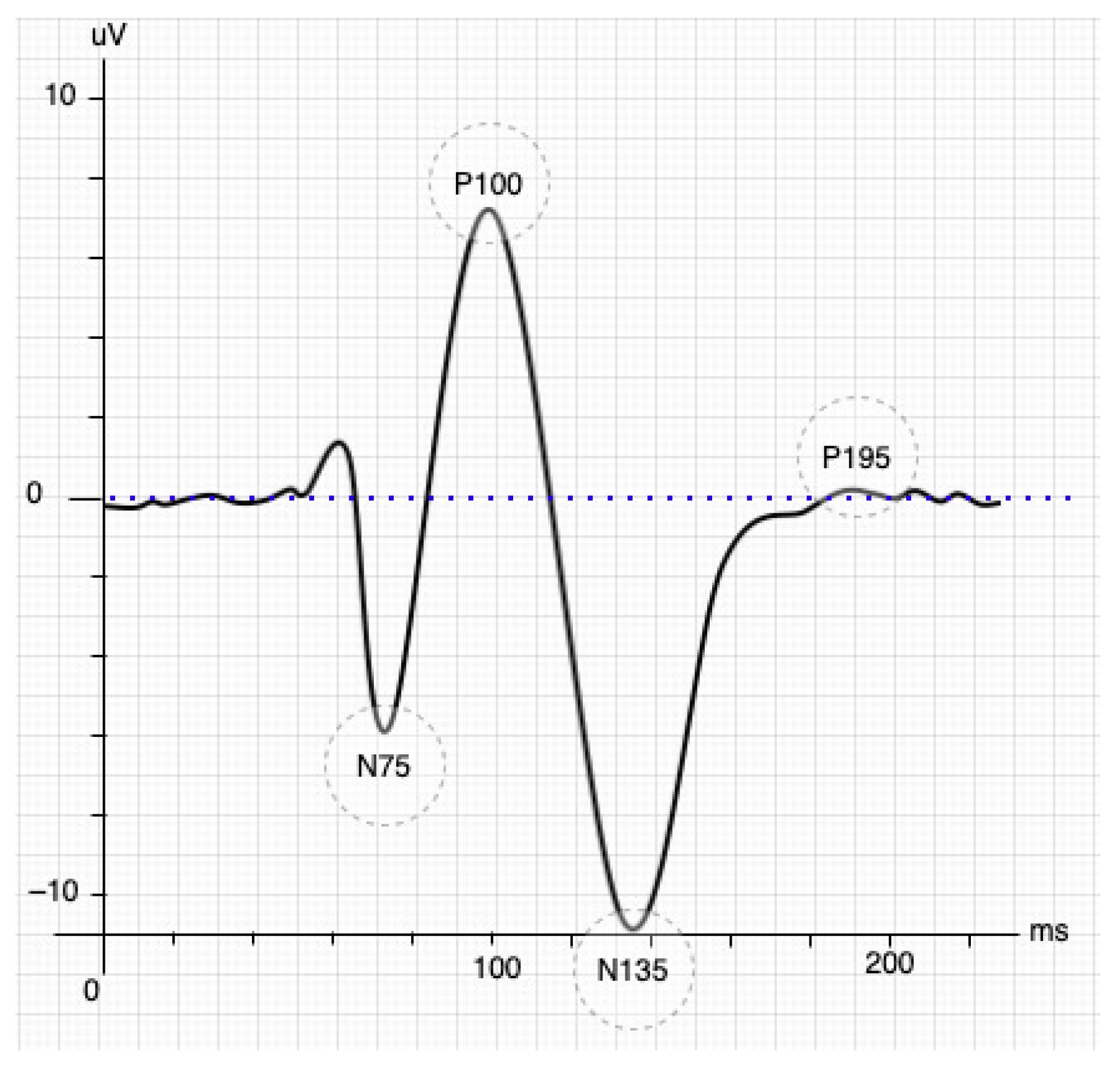


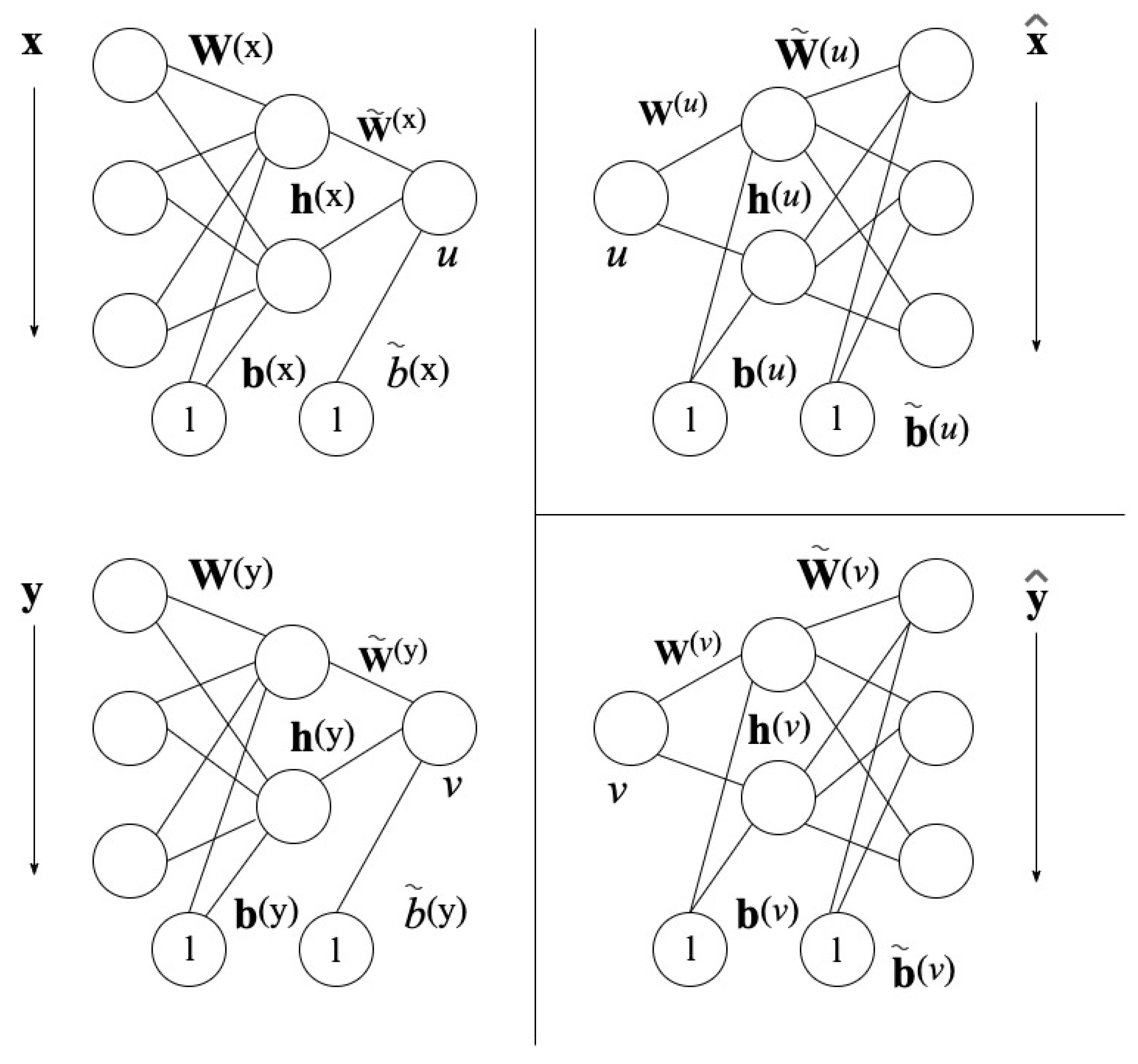
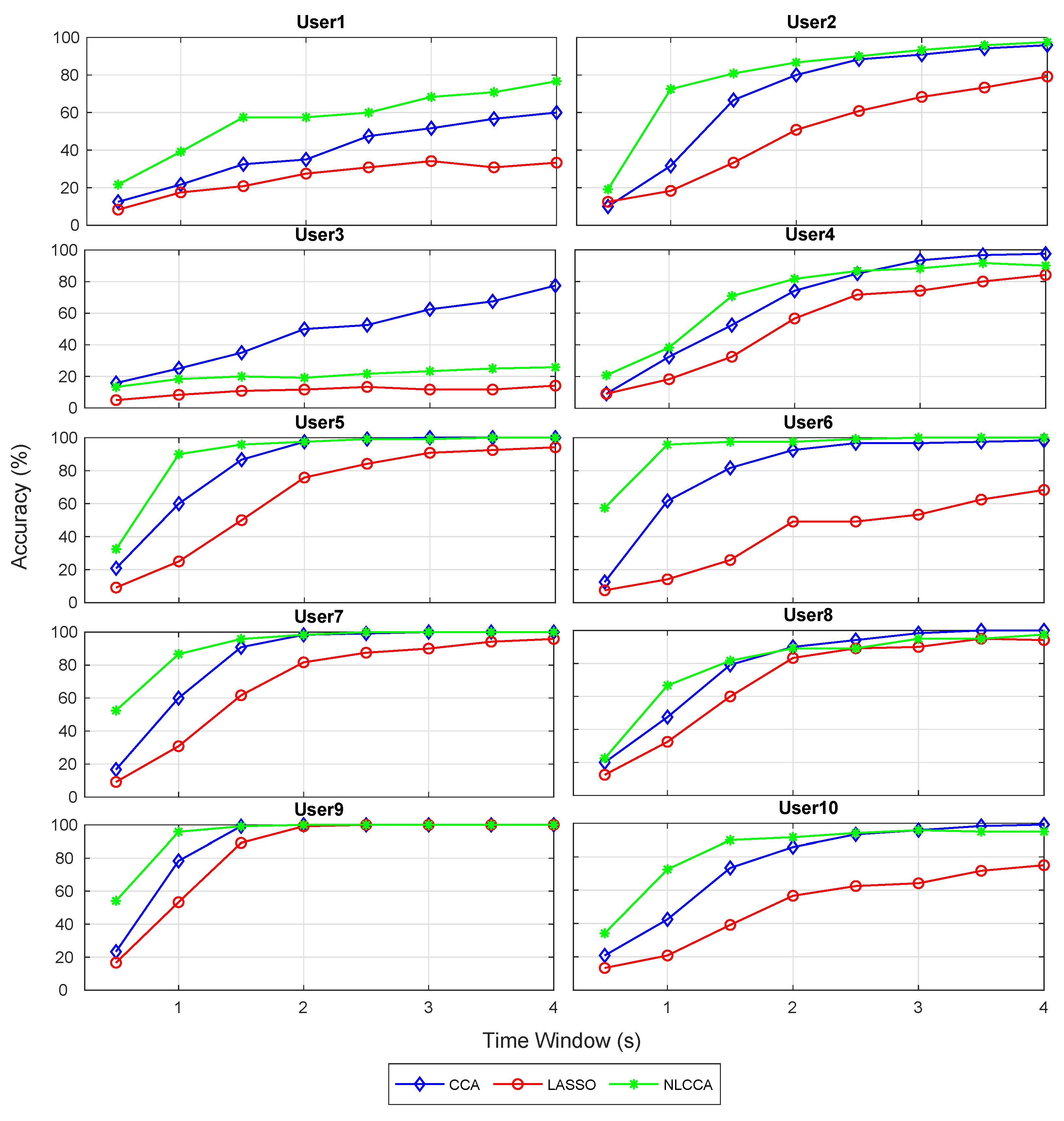



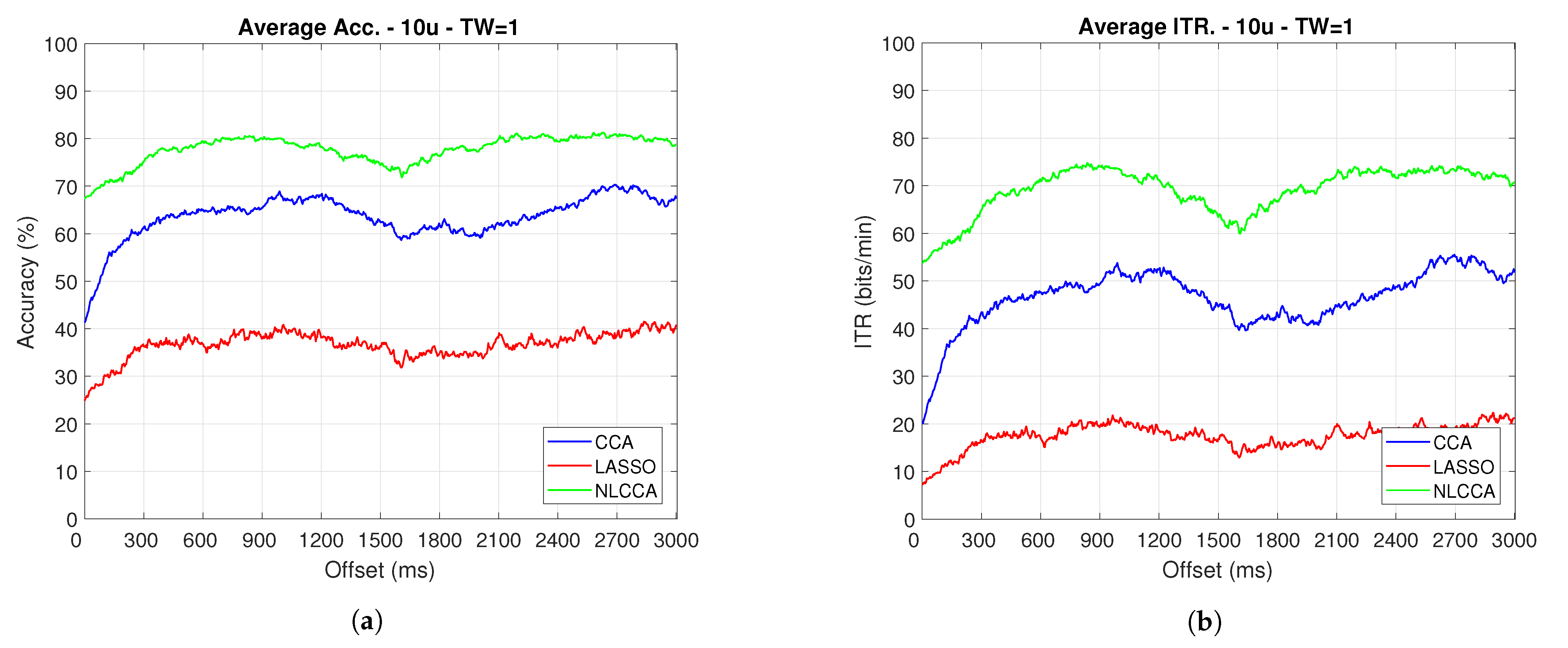
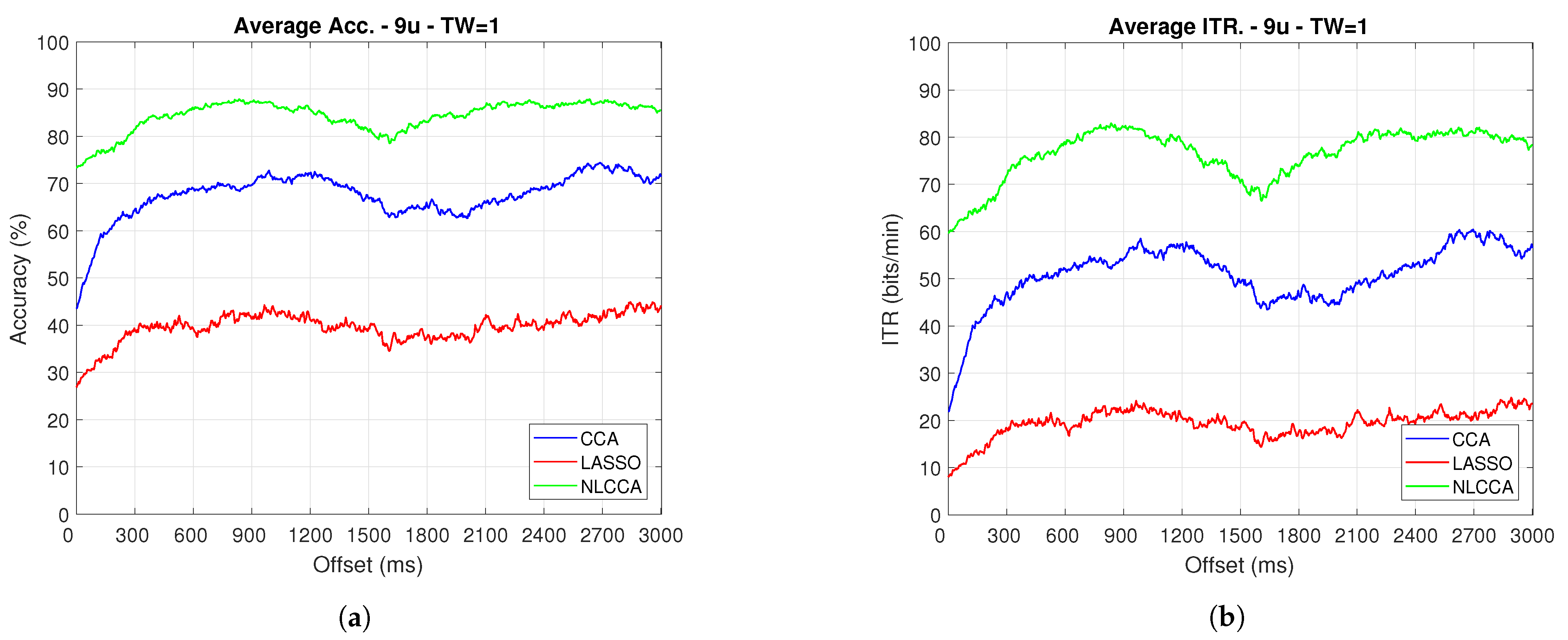

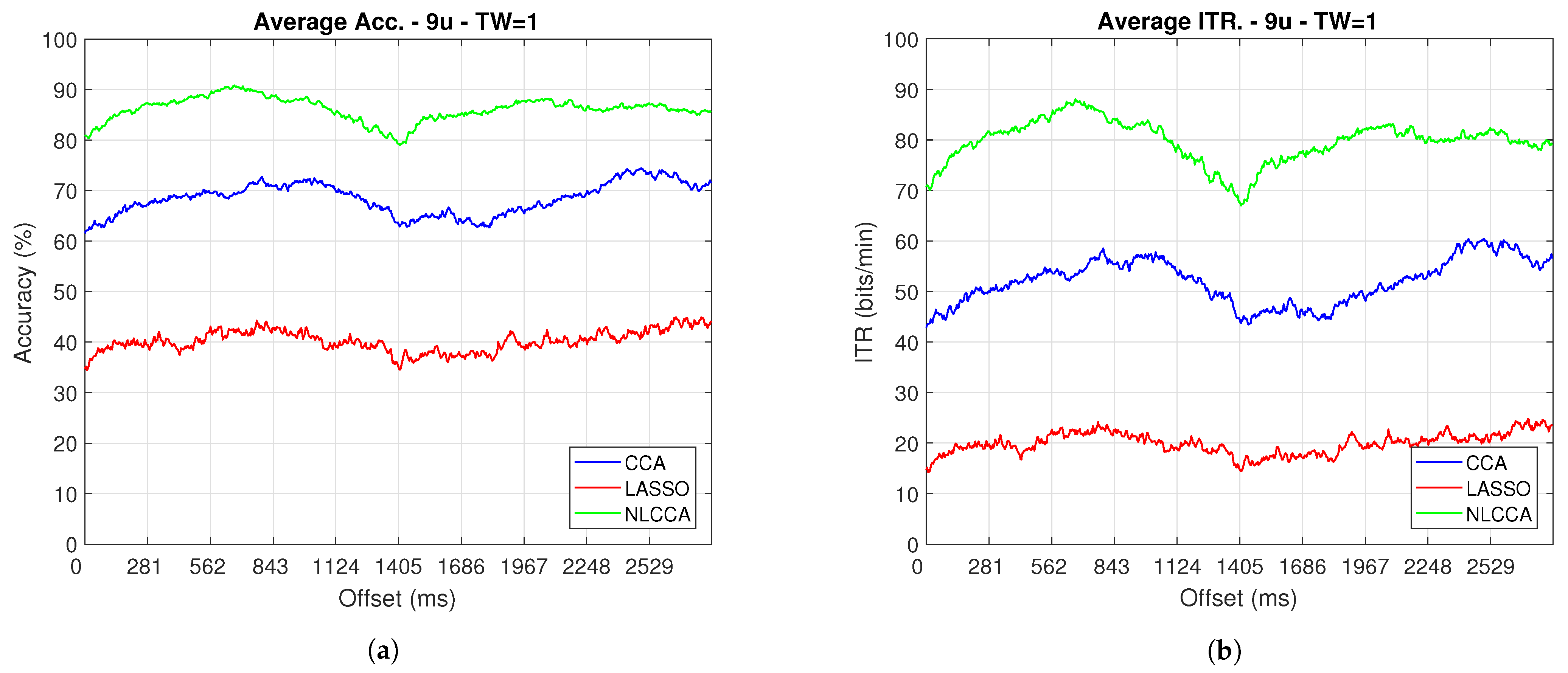
| LASSO | CCA | NLCCA | |||||||
|---|---|---|---|---|---|---|---|---|---|
| Subject | TW | Acc | ITR | TW | Acc | ITR | TW | Acc | ITR |
| (s) | (%) | (bit/min) | (s) | (%) | (bit/min) | (s) | (%) | (bit/min) | |
| S1 | 3 | 34.17 | 5.72 | 4 | 60 | 14.76 | 1.5 | 57.5 | 27.14 |
| S2 | 4 | 79.17 | 25.51 | 2.5 | 88.33 | 45.63 | 1 | 72.5 | 53.55 |
| S3 | 0.5 | 5 | 0.48 | 4 | 77.5 | 24.45 | 3.5 | 25 | 2.38 |
| S4 | 2.5 | 71.67 | 29.91 | 3 | 93.33 | 45.01 | 2 | 81.67 | 45.27 |
| S5 | 3 | 90.83 | 42.39 | 2 | 97.5 | 66.6 | 1 | 90 | 83.1 |
| S6 | 4 | 68.33 | 19.07 | 2 | 92.5 | 58.82 | 1 | 95.83 | 95.73 |
| S7 | 2 | 81.67 | 45.27 | 2 | 98.33 | 68.1 | 1 | 86.67 | 76.72 |
| S8 | 2 | 83.33 | 47.17 | 2 | 90 | 55.4 | 1.5 | 81.67 | 54.32 |
| S9 | 2 | 99.17 | 69.73 | 1.5 | 99.167 | 83.68 | 1 | 95.83 | 95.73 |
| S10 | 3.5 | 71.67 | 23.26 | 2.5 | 93.33 | 51.45 | 1.5 | 90 | 66.48 |
| Avg. | 2.65 | 68.50 | 30.85 | 2.55 | 88.99 | 51.39 | 1.5 | 77.67 | 60.04 |
| Avg. (w/o S3) | 2.89 | 75.56 | 34.23 | 2.39 | 90.28 | 54.38 | 1.28 | 83.52 | 66.45 |
| LASSO | CCA | NLCCA | ||||||||
|---|---|---|---|---|---|---|---|---|---|---|
| Mean | STD | CV (%) | Mean | STD | CV (%) | Mean | STD | CV (%) | ||
| Accuracy | 10 user | 37.20 | 1.94 | 5.21 | 64.44 | 3.00 | 4.66 | 80.54 | 2.37 | 2.95 |
| 9 user | 40.19 | 2.12 | 5.28 | 68.41 | 3.15 | 4.61 | 86.14 | 2.37 | 2.75 | |
| ITR | 10 user | 17.95 | 1.91 | 10.64 | 47.54 | 4.16 | 8.74 | 72.58 | 3.94 | 5.43 |
| 9 user | 19.91 | 2.12 | 10.65 | 51.95 | 4.50 | 8.67 | 79.65 | 4.22 | 5.30 | |
| Case | Source Variability | GDL | Sum Squares | Mean Squares | Fc | F (95%) |
|---|---|---|---|---|---|---|
| Accuracy (10 users) | Treatments | 2 | 690,084.705 | 345,042.35 | 56,214.05 | 3 |
| Error | 2154 | 13,221.27 | 6.138 | |||
| Total | 2156 | 703,305.98 | ||||
| 56,214.05 > 3 | ||||||
| Accuracy (9 users) | Treatments | 2 | 772,312.22 | 386,156.11 | 57,822.38 | 3 |
| Error | 2154 | 14,385.1 | 6.68 | |||
| Total | 2156 | 786,697.31 | ||||
| 57,822.38 > 3 | ||||||
| ITR (10 users) | Treatments | 2 | 1,075,514.163 | 537,757.08 | 44,268.26 | 3 |
| Error | 2154 | 26,166.12 | 12.15 | |||
| Total | 2156 | 1,101,680.28 | ||||
| 44,268.26 > 3 | ||||||
| ITR (9 users) | Treatments | 2 | 1,285,243.27 | 642,621.635 | 45,287.186 | 3 |
| Error | 2154 | 30,565.09 | 14.19 | |||
| Total | 2156 | 1,315,808.36 | ||||
| 45,287.186 > 3 | ||||||
| Case | Hypothesis | Coefficient | Comparison | ||
|---|---|---|---|---|---|
| q (5%) 3,2154 | |||||
| Accuracy (10 users) | : | 27.24 | 3.32 | 0.306 | 27.24 > 0.306 |
| : | 43.34 | 43.34 > 0.306 | |||
| : | 16.1 | 16.1 > 0.306 | |||
| Accuracy (9 users) | : | 28.22 | 3.32 | 0.32 | 28.22 > 0.32 |
| : | 45.95 | 45.95 > 0.32 | |||
| : | 17.73 | 17.73 > 0.32 | |||
| ITR (10 users) | : | 29.59 | 3.32 | 0.431 | 29.59 > 0.431 |
| : | 54.63 | 54.63 > 0.431 | |||
| : | 25.04 | 25.04 > 0.431 | |||
| ITR (9 users) | : | 32.04 | 3.32 | 0.466 | 32.04 > 0.466 |
| : | 59.74 | 59.74 > 0.466 | |||
| : | 27.7 | 27.7 > 0.466 |
Publisher’s Note: MDPI stays neutral with regard to jurisdictional claims in published maps and institutional affiliations. |
© 2021 by the authors. Licensee MDPI, Basel, Switzerland. This article is an open access article distributed under the terms and conditions of the Creative Commons Attribution (CC BY) license (https://creativecommons.org/licenses/by/4.0/).
Share and Cite
De la Cruz-Guevara, D.R.; Alfonso-Morales, W.; Caicedo-Bravo, E. Solving the SSVEP Paradigm Using the Nonlinear Canonical Correlation Analysis Approach. Sensors 2021, 21, 5308. https://doi.org/10.3390/s21165308
De la Cruz-Guevara DR, Alfonso-Morales W, Caicedo-Bravo E. Solving the SSVEP Paradigm Using the Nonlinear Canonical Correlation Analysis Approach. Sensors. 2021; 21(16):5308. https://doi.org/10.3390/s21165308
Chicago/Turabian StyleDe la Cruz-Guevara, Danni Rodrigo, Wilfredo Alfonso-Morales, and Eduardo Caicedo-Bravo. 2021. "Solving the SSVEP Paradigm Using the Nonlinear Canonical Correlation Analysis Approach" Sensors 21, no. 16: 5308. https://doi.org/10.3390/s21165308
APA StyleDe la Cruz-Guevara, D. R., Alfonso-Morales, W., & Caicedo-Bravo, E. (2021). Solving the SSVEP Paradigm Using the Nonlinear Canonical Correlation Analysis Approach. Sensors, 21(16), 5308. https://doi.org/10.3390/s21165308







